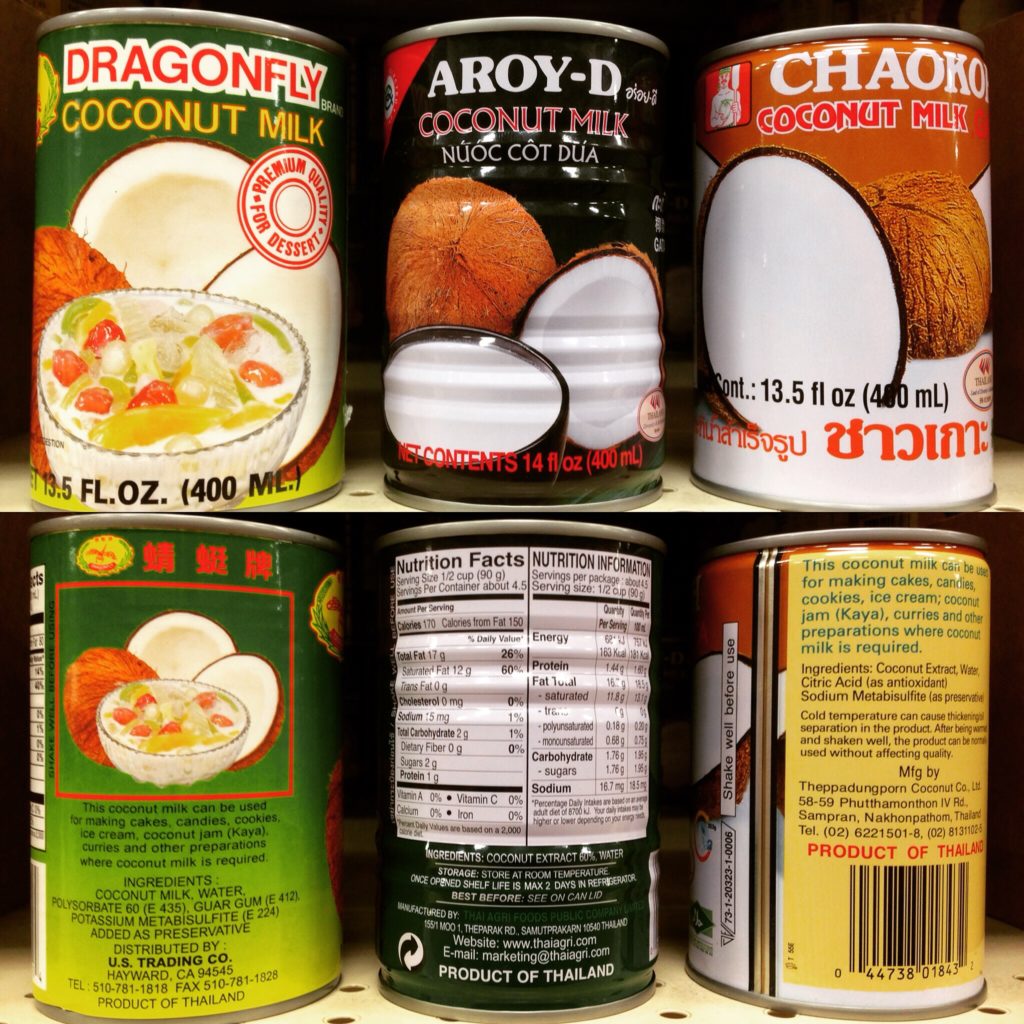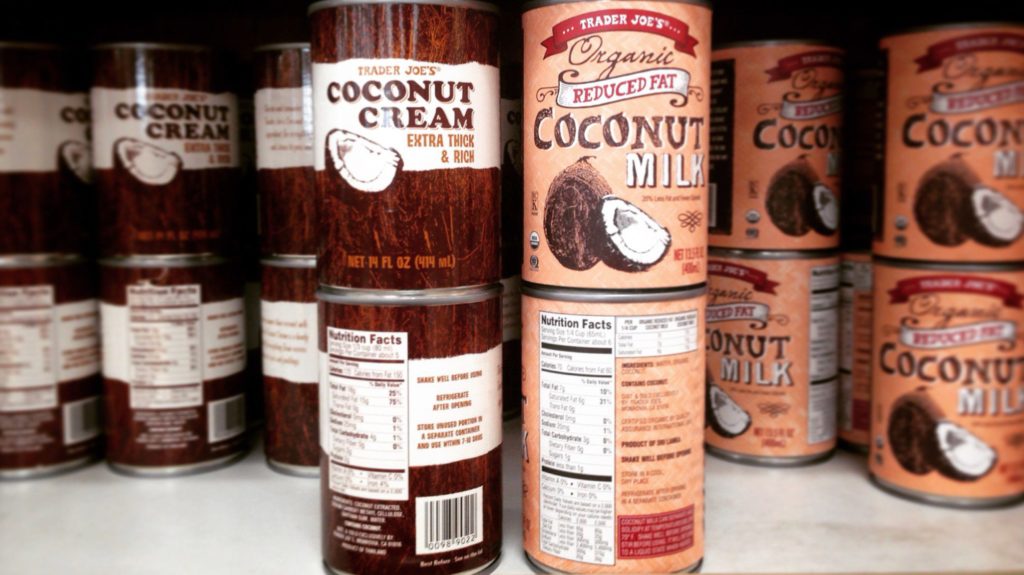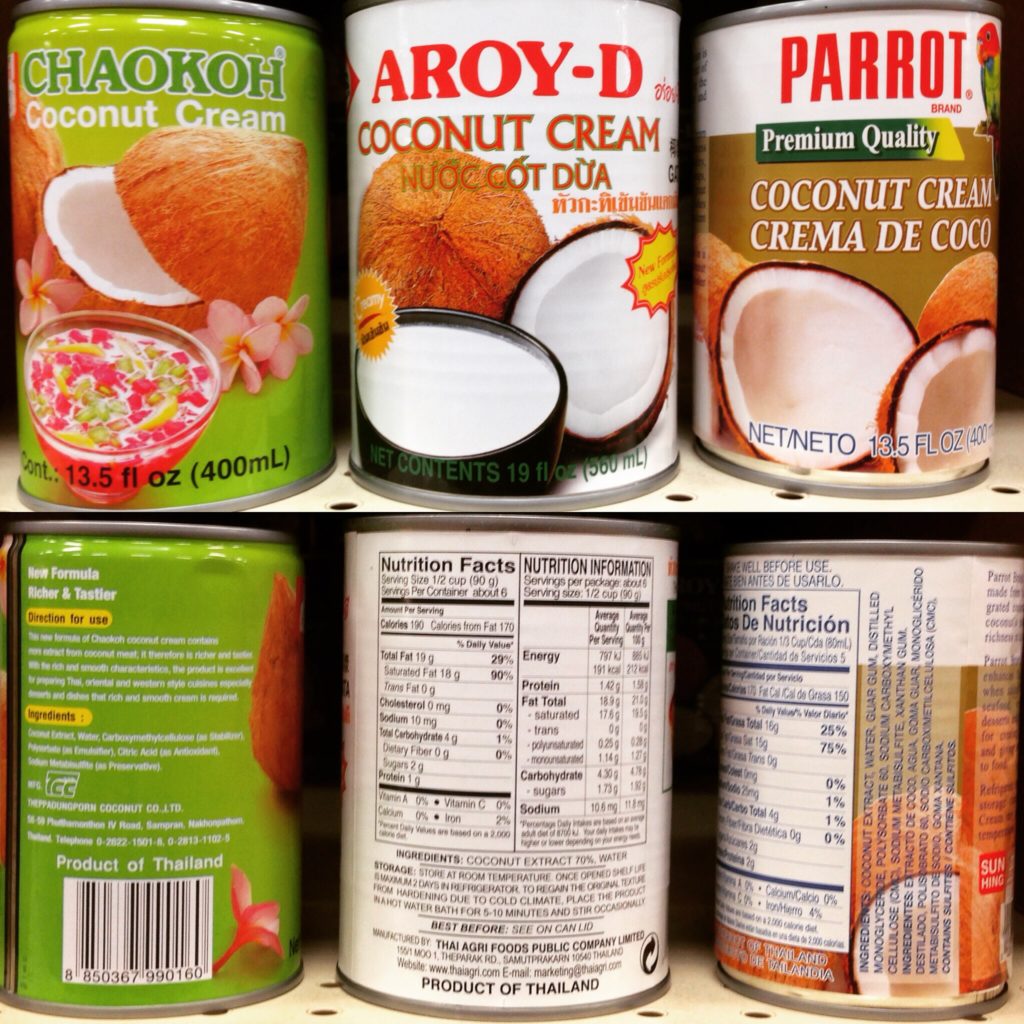Try to buy coconut milk at your local everything-grocer, and your decision will be made for you. You’ll find at most a couple options, all overpriced. Found an Asian market? Nice move, but you may now have another problem—a surplus of selection. How will you decide what to buy?
A standard product-review solution would be to purchase them all; assemble a panel of expert supertasters; perform a blind taste test; and identify your favorite product and acceptable alternatives. This sounds like… actually a lot of fun. Readers are encouraged to do exactly this, and Instagram the results #kitchenminimal #coconutmilk @engineerexplore.
This also sounds entirely unrealistic. Even if a trusted source does it for you (and so they have), there’s problem with this strategy: with so many options out there in the aisles, you may not always find your favored product. Fortunately, for a product as straightforward as this one, there’s an easy alternative.
Read the label
Which is the best coconut milk? The answer is on the can.
1. Contains only coconut extract and water.
2. Maximizes the former.
Minimize ingredients
Coconut milk is produced by extracting the coco-nuttiness of coconut flesh into water, and diluting it to the desired consistency.1 As such it requires two ingredients. Which do you think they are?
- Coconut extract
- Water
- Sodium metabisulfite
- Sodium benzoate
- Polyoxyethylene sorbitan tristearate
- Guar gum
- Sodium carboxymethyl cellulose
I hope the answer is obvious. With this knowledge, your decision will almost make itself: unless you insist on your ‘aqueous coconut product’2 being bleached3, emulsified4, preservative-laden5, or artificially thickened6, finding the best coconut milk entails simply finding the can that contains only coconut milk.
If the fewest ingredients you’ve found is three, you’re probably looking at sodium metabisulfite. Fretting may not be warranted unless you have a specific sensitivity: this is the ingredient behind the “contains sulfites” label on most bottles of wine.
Let’s try it out. Which of these cans should we drop in the basket?

Aroy-D: Coconut extract 60%, water.
Chaokoh: Coconut extract, water, citric acid, sodium metabisulfite.
Maximize fat
Coconut extract and water. Of these, which flows freely from your kitchen sink? It’s not coconut, so that’s the ingredient to maximize in your can. (Even if watered-down is what you want, that’s something you can do at home.) Upstanding producers will tell you precisely how much coconut they’re giving you—60% is spectacular, as in the can of Aroy-D above. Unfortunately, this is uncommon. For an indirect indication, look to fat content: more fat means less watered down. Serving size may vary, so prepare yourself for some long division as you compare total fat to serving size, each in grams. The minimum for regular coconut milk is 10% fat2, but the best will approach 20%. This permits a shortcut calculation: multiply fat grams by 5; if this number approaches the serving size in grams, you’ve found a solid product.
For example, our can of Aroy-D contains 17 grams of fat. 17 times 5 is 85, just shy of the 90 gram serving size. Disco.
Coconut Cousins
A browse down the shelf (or through the aforementioned Codex Standard for Aqueous Coconut Products2) reveals a pair of adjacent canned coconut products: “light” (or “reduced fat”) coconut milk and coconut cream. Evaluating these products is simple, as the same rules apply. But brace yourself—you may not be thrilled with what you find. As a case study, consider the cans on offer at Trader Joe’s:

Trader Joe's Organic Reduced Fat Coconut Milk: Water, coconut extract.
Light coconut milk
“Light” means “less fat”. You can probably already see the problem: in the context of coconut milk, “less fat” means “less coconut”. Ergo, “light” versions are (at best) simply watered down. This is illustrated on the Trader Joe’s can above, where water, listed first, makes up the majority of the can. Many such products also add chemical thickeners to make up for the deficit of real coconut. (Admirably, this one does not.)
The upshot: light coconut milk is a ridiculous product that has no business in your pantry. Even if you remain fat-averse despite new science (and the present popularity of coconut oil), save your money and thin it out on your own.
Coconut cream
Coconut cream is the opposite: a thicker, heavier, fattier concentration of coconut. By our second standard this should be appealing stuff—at the right price point, even more coco for your cash. In practice it’s rarely an attractive option, typically overloaded with unnecessary chemicals. Trader Joe’s version above is case in point: a disappointing contrast to their light product’s ingredients list. Once again, Aroy-D’s product passes our tests; pictured below alongside a less attractive competitors.

Aroy-D: Coconut extract 70%, water.
Parrot: Coconut extract, water, guar gum, distilled monoglyceride, polysorbate 60, sodium carboxylmethylcellulose, sodium metabisulfite, xanthan gum.
Canned Answers
If a scan of the label is too much work, here’s my recommendation: Aroy-D products seem to be consistently free of additives, coconut-dense, and transparently labeled.
If you don’t mind sulfites, Chaokoh is a popular and well-reviewed alternative, though their coconut cream is far less pristine.
Trader Joe’s theoretically carries a full-fat coconut milk product that meets all our criteria, is competitively priced, and is organic to boot. Perhaps as a testament to its excellence, it is also consistently out of stock—so if you happen to find it, consider stocking up.
Stock the Virtual Pantry
Enough of this little piggy’s market experience. What did YOU pull off the shelf? How does it rate, and what did you make with it?
2 Codex Standard for Aqueous Coconut Products – Food and Agriculture Organization of the United Nations
3 Ibid, Section 4.1: Bleaching Agents. (Unbleached is plenty white.)
4 Ibid, Section 4.2: Emulsifiers. (So what if it separates?)
5 Ibid, Section 4.3: Preservatives. (Unnecessary with proper processing.)
6 Ibid, Section 4.4: Stabilizers/thickeners. (A sign you’re being cheated out of actual coconut milk.)


